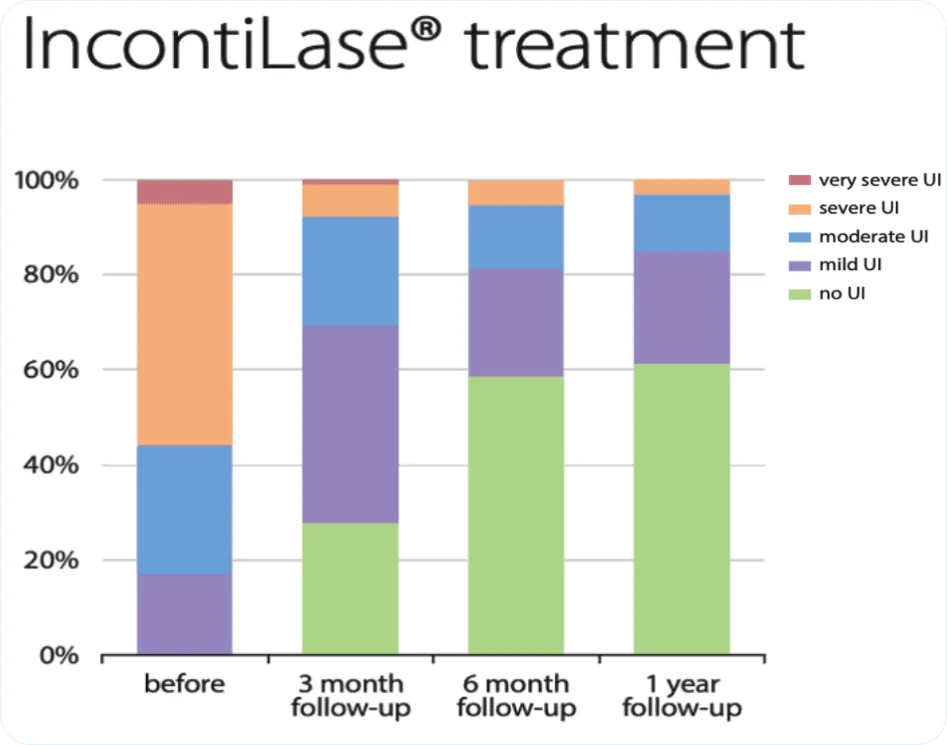At QHC Wellness, our IncontiLase laser treatment provides a fast, non-invasive solution to incontinence, restoring bladder control without surgery or downtime.
Urinary incontinence is a complex condition that affects millions of women worldwide, leading to unintentional urine leakage due to weakened bladder muscles, nerve damage, or other underlying health conditions. This condition can significantly impact daily life, causing discomfort and embarrassment. Women are more commonly affected due to factors like pregnancy, childbirth, and menopause, but it can affect men as well.


This type of incontinence occurs when pressure is applied to the bladder during activities such as coughing, sneezing, laughing, or exercising. The pelvic floor muscles, weakened by childbirth or aging, can no longer adequately support the bladder, leading to leakage.

Often referred to as overactive bladder, urge incontinence is marked by a sudden, uncontrollable urge to urinate, typically caused by involuntary bladder contractions. It may be triggered by nerve damage, bladder irritation, or neurological conditions.

This occurs when the bladder doesn’t empty properly, leading to frequent or constant dribbling. Overflow incontinence is often related to a blocked bladder outlet or nerve damage.

In this type, physical or mental impairments (such as arthritis or neurological issues) make it difficult to reach the bathroom in time.
women suffer from some form of incontinence
women after childbirth experience pelvic prolapse
women over 50 will encounter vaginal atrophy
While not always avoidable, understanding key risk factors can help reduce your chances of developing urinary incontinence:
Extra pressure on the bladder weakens pelvic floor muscles, increasing the risk of leakage. Weight loss can alleviate symptoms.
Chronic coughing from smoking strains pelvic muscles and doubles the risk of stress incontinence.
Caffeine, alcohol, carbonated drinks, and spicy foods can irritate the bladder and worsen urge incontinence. Cutting these from your diet may help.
Chronic constipation and straining weaken pelvic muscles. Increasing fiber and fluids can prevent this.
Menopause leads to lower estrogen levels, weakening pelvic tissues and bladder control.
The strain of pregnancy and vaginal delivery can damage bladder-supporting muscles.
As you age, muscle strength in the bladder and pelvic area declines, increasing the likelihood of incontinence.
Did you check more than 2 risk factors? You may
need a specialist
appointment

Regain your confidence and control with IncontiLase, the latest innovation in stress urinary incontinence treatment available at QHC Wellness. This non-invasive, cutting-edge laser therapy boosts collagen production in the vaginal wall, strengthening your pelvic floor muscles and restoring bladder control—all without the need for surgery or anesthesia. Quick, effective, and with minimal recovery time, IncontiLase is your solution to long-term relief.
Want to try this out?
With no incisions, no cutting, and no surgical risks, IncontiLase offers a completely non-invasive solution, making it safer and less daunting than traditional procedures. You get real results without the trauma of surgery.
Forget the fear of needles or anesthesia. IncontiLase is virtually painless, requiring only a mild numbing cream. Most patients report feeling nothing more than gentle warmth, allowing you to relax throughout the procedure.
No downtime means you can resume your daily activities right after treatment. This makes IncontiLase perfect for those with busy schedules who can’t afford lengthy recovery periods.
Backed by clinical studies, IncontiLase consistently delivers high satisfaction rates, with patients experiencing significant relief from urinary incontinence.
IncontiLase doesn’t just provide temporary relief. The collagen production stimulated by the procedure strengthens the pelvic floor over time, offering enduring results and improved quality of life.

IncontiLase utilizes Fotona SMOOTH® technology, a highly advanced laser system that delivers precise, controlled laser light to the vaginal mucosa. This technology is specially designed for non-ablative, thermal treatments, meaning it heats the tissues without damaging the surface.
The laser targets the collagen fibers within the vaginal wall, stimulating natural collagen production. As new collagen forms, it leads to tightening and strengthening of the vaginal tissues, including the connective structures that support the bladder and urethra. This process reinforces the pelvic floor muscles, providing better bladder support and reducing involuntary urine leakage associated with stress urinary incontinence.
What makes Fotona SMOOTH® technology unique is its ability to induce photothermal stimulation—a gentle heating process that triggers tissue regeneration without cutting or ablating the skin. This stimulates the body’s natural healing response, remodeling the tissue and improving the structural integrity of the vaginal wall. Over time, this results in a firmer, more resilient pelvic floor that can better support bladder function.
Want to learn more about Fotona SMOOTH technology?
Enhances bladder control
Reduces related symptoms
Walk-in, walk-out procedure
Safe and non-invasive
Typically completed in 30 minutes




Most patients see noticeable improvement after just one treatment. However, depending on the severity of the condition, some may require two to three sessions spaced out over several weeks to achieve optimal results. The exact number of sessions will vary based on the individual's response to the treatment and the extent of their incontinence.

IncontiLase is generally considered a safe and low-risk procedure. However, some patients may experience mild side effects such as temporary swelling, redness, or discomfort in the treated area, which usually subsides within a few days. Since the procedure is non-invasive, more serious risks like infection or scarring are extremely rare.

IncontiLase is not recommended for: Pregnant women, Individuals with active vaginal infections, Those with severe prolapse or advanced incontinence, which may require surgical intervention. Patients should consult with their doctor to ensure that they are good candidates for the procedure.

IncontiLase offers long-lasting results, but the exact duration can vary. For most patients, the benefits can last for 12 to 18 months or longer. Some patients may require a touch-up treatment every year or two to maintain optimal bladder control, especially as aging and other factors affect pelvic floor strength over time.

Since IncontiLase is typically considered an elective cosmetic procedure, it is usually not covered by insurance. Patients should check with their provider for specific coverage details, but many practices offer financing options to make the treatment more affordable.

IncontiLase is primarily designed for women with stress urinary incontinence due to the anatomical structure of the vaginal wall and pelvic floor. Men with urinary incontinence may require different treatments such as pelvic floor therapy or surgery, depending on the cause of their symptoms.

Patients are typically advised to avoid intercourse or the use of vaginal creams or medications for at least 24-48 hours before the procedure. Your provider will give you specific instructions based on your individual case, but no significant preparation (such as fasting) is usually necessary.

If you're experiencing urinary incontinence, IncontiLase could be the solution you've been looking for. Don't wait—take control today!
